

Interactive Greek Gods Family Tree. Latin I - FCLTA. DL - Latin Lit Class - Carmina, or Poems. Roman_empire. Regnum_Animale.png (2376×1497) Family Tree Diagram of Greek Mythology. The ancient Greeks had a vast list of various deities, mythical beings and legendary characters in their culture.
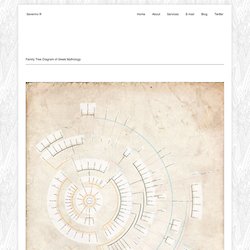
My task was to take their many mythical figures and show their relation to each other in one diagram. My response was a detailed family tree system, that shows the origin of all these characters exploding out of "Chaos", their point of origin. I had to design the diagram in a way that it could handle the huge amount names and interactions, while still being visually clear and easy to follow. ← Previous Piece ↑ Top Next Piece → LatinTests.net - interactive quizzes for Latin learners. Latine Discere–Study Guide. Study Guides The PDF files shown below can be printed from any computer, provided you have the free Adobe Acrobat Reader.
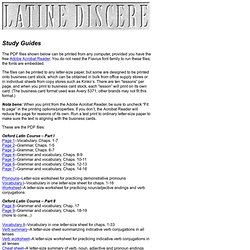
You do not need the Flavius font family to run these files; the fonts are embedded. The files can be printed to any letter-size paper, but some are designed to be printed onto business card stock, which can be obtained in bulk from office supply stores or in individual sheets from copy stores such as Kinko’s. There are ten “lessons” per page, and when you print to business card stock, each “lesson” will print on its own card. (The business card format used was Avery 5371; other brands may not fit this format.) Nota bene: When you print from the Adobe Acrobat Reader, be sure to uncheck “Fit to page” in the printing options/properties.
These are the PDF files: Oxford Latin Course – Part II Page 8–Grammar and vocabulary, Chap. 17 Page 9–Grammar and vocabulary, Chaps. 18-19 (more to come...) Latin LOLCats. Internet Workbook for the Oxford Latin Course. This workbook is designed to help students practice and review material associated with the Oxford Latin Course (OLC).

The OLC emphasizes reading and oral question and answer as the primary ways of learning Latin, but it makes some use of formal grammar. While the thrust of this approach differs from the older grammar-based methods, students still need practice with declension and conjugation paradigms and rules of syntax. This workbook provides an easy way for students to practice the Latin forms and receive immediate feedback on their answers. The workbook may be used outside of class for extra practice, by homeschoolers using the OLC, or it may be used as part of a class in a computer lab environment. For those using other texts, or reviewing Latin grammar, use the Grammar Index. These pages make heavy use of javascript to give you feedback about your performance.
Internet Workbook for the Oxford Latin Course © 1999-2006, Robert W. OL drills. Home. Carmen Possum. Carmen Possum is a popular 80-line macaronic poem written in a mix of Latin and English.

Its author is unknown, but the poem's theme and language enable one to surmise that he or she was from the United States of America and was either a teacher or at least a student of Latin. Www.txclassics.org/journalexcerpts/OralExam.pdf. Texas Classical Association. Articles featured on this web page have previously been published in Texas Classics in Action, the biannual journal of the Texas Classical Association.
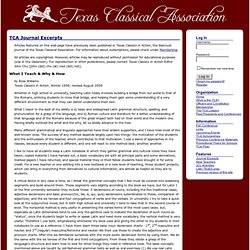
For information about subscriptions, please check under Membership. All articles are copyrighted. However, articles may be reproduced without permission for educational purposes (use in the classroom). Open University Interactive Latin. Writingpassion / English Poems in Hendecasyllabic. Resources for Students - Matthew C. Farmer. Two Hundred Essential Latin Words. Creating from the Top Down « Embedded Reading. *All of the versions of this story are created from “La Noche Boca Arriba” by Julio Cortazar.
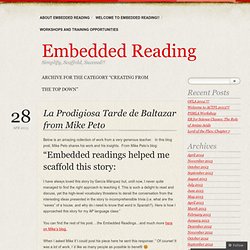
Schoolhouse Widgets: Latin Lolcats Script. Lexicon Recentis Latinitatis, parvum verborum novatorum Léxicum. LATINITASOpus Fundatum in Civitate Vaticana PARVVM VERBORVM NOVATORVM LÉXICVM [1]apparavit Cletus Pavanetto [1] Verba novata magnam partem depromuntur ex operoso ópere cui títulus Léxicon Recentis Latinitatis cura et stúdio Óperis Fundati «Latínitas» ante áliquot annos foras dato.
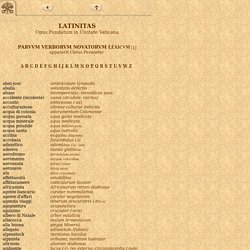
Latin Dictionary Online Translation LEXILOGOS. Synopsis of Latin Infinitives and How to Produce the Infinitive Forms in Latin (cf. Wheelock 25) (Cf.
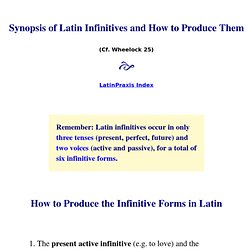
Wheelock 25) LatinPraxis Index Remember: Latin infinitives occur in only three tenses (present, perfect, future) and two voices (active and passive), for a total of six infinitive forms. 1. The present active infinitive (e.g. to love) and the present passive infinitive (to be loved) derive from the second principal part: Www.slu.edu/colleges/AS/languages/classical/latin/tchmat/grammar/vb/05200 vbsynexx.pdf. Www.slu.edu/colleges/AS/languages/classical/latin/tchmat/grammar/vb/05100 conventions.pdf. Www.slu.edu/colleges/AS/languages/classical/latin/tchmat/grammar/vb/04800 synblankeng.pdf. Www.slu.edu/colleges/AS/languages/classical/latin/tchmat/grammar/vb/04600 vbsyn c1-4 pparts.pdf. ACL Institute: Latin Immersion. Linguam Latinam Latine Doceamus!
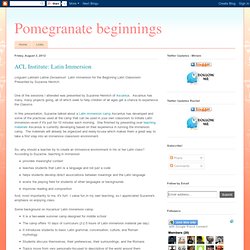
Latin Immersion for the Beginning Latin ClassroomPresented by Suzanne Henrich One of the sessions I attended was presented by Suzanne Heinrich of Ascanius. Ascanius has many, many projects going, all of which seek to help children of all ages get a chance to experience the Classics. In this presentation, Suzanne talked about a Latin immersion camp Ascanius has developed and some of the practices used at the camp that can be used in your own classroom to initiate Latin immersion--even if it's just for 10 minutes each morning. She finished by presenting over teaching materials Ascanius is currently developing based on their experience in running the immersion camp. The materials will already be organized and ready-to-use which makes them a great way to take a first step into an immersive classroom environment.So, why should a teacher try to create an immersive environment in his or her Latin class?
And, most importantly to me, it's fun! Inscriptions of Roman Tripolitania. The Roman Empire stretched over large parts of what is now known as the Middle East and into Africa.
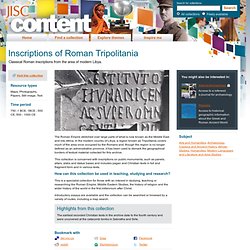
In the modern country of Libya, a region known as Tripolitania covers much of the area once occupied by the Romans and, though the region is no longer defined as an administrative province, it has been used to demark the geographical borders of textual material collected for this archive. This collection is concerned with inscriptions on public monuments, such as panels, altars, slabs and statue bases and includes pagan and Christian texts in full and fragment form and in various texts.
Children and Youth in History. Beryl Rawson, Professor Emerita and Adjunct Professor, Classics Program Australian National University Why I Taught the Sources I use images of two Roman marble sarcophagi for topics on children and childhood in undergraduate courses on ancient society, family, gender, representations, and historiography.
The sarcophagi can be used to study one period of antiquity or to examine changing notions of childhood over time. My aim in using the sarcophagi is to increase students' awareness of the rich variety of accessible material sources about Roman society—especially archaeological resources such as art, architecture, inscriptions, and topography—that can supplement traditional literary sources. A Sight Reading Approach to Using the DCC. One of the key features of the DCC site is that each text comes equipped with hand-made running vocabulary lists, containing the main definitions for each word, but also the particular one relevant to the context.
Very common words are excluded. These take a lot of effort to prepare, of course, so I thought it would be good to explain why we do this. The point is not just to make it easier for readers to find the correct lemma behind a given form (something automated tools are still very bad at). It also allows for a way of teaching that focuses students’ out of class efforts on vocabulary acquisition and comprehension, rather than the (much harder task of) translation.
A vocabulary-focused sight reading approach can help fight the bane of Latin and Greek pedagogy: students writing down the “correct” translation in class, and giving it back on tests, which improves their ability to memorize English, but doesn’t do much for their Latin or Greek. 10 Great Blogs for Language Learners. Last year I shared Get Ready! Ten Bloggers You Should Read. Most of those blogs are still fantastic resources for the everyday language learner to check into for great ideas, inspiration and a little bit of language learning fun. But it’s a new year and there are some great new blogs that are also great resources. In that post I mentioned Abraham Lincoln’s quote: If I were given ten hours to cut down a tree, I would spend the first six sharpening the saw. That is the reason I want to encourage you to find other great blogs to read as an everyday language learner – there is so much to learn from those who are further along on the journey.
The Latin Teacher. Romus Domus/Pompeii. List of Ancient Roman Temples. LVDVS: Web for learning Latin. Conversational latin. TamingCaesar.pdf. VL partescorporis. Latin Phrases.